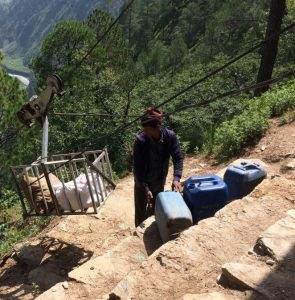General Information:
About 40% Nepalese women are economically active and they bear the double burden of works in the family chores and doing farm works. But, the women from Manaagaun and its periphery have extra burden of fetching household consumable goods from Tipada, a nearby rural market with one and half kelometre distance. Anyone who wants to cross this distance has to face challenges and risk posed by Rudakhocha Vir, a hill having sharp-sloppy landscape.
Being a development worker, when I was through the hill I found it a terrifying adventure whereas men and women of the areas had no other options but to walk frequently on those dangerous slopes carrying more than 50 kg weight on their back before the operation of ropeway. If anything untoward happens, there is no way to get away from the highly possible fatal accident. If you look beyond the edge of the walking trail, you’ll see below the slopes descending to Budhiganga River which is scary, even to look at. The trail is so narrow that it looks like two big snakes hardly crossing each other!
Installation of Gravity Goods Ropeway:
The situation no longer remained the same. After the installation of a Gravity Goods Ropeway[1] (GGR) no one now needs to travel on such risky road shouldering heavy belongings. The system was installed connecting Tipada (rural market center) and Manaagaun (remote village) of Bajura district, in November 2016. It is 908 metres long with an inclination of 34 degree. While installing the system under the financial and technical support of BICAS project, there were two expectations: to reduce women’s drudgery and enhance income of local households by ensuring easy circulation of local products, here however I will only discuss about the first expectation.
Operation of the system:
For its smooth functioning, a GGR management committee is formed and a member of it operates the system twice a week- Wednesday and Saturday for about 3 hours per operating day. In 3 hours, about 16 trips of different goods are usually shipped up and down, which guaranties two-way income to the management committee. Part of such income will be used for its repairing and maintenance purposes to continue its services in the future.
People’s recognition:
While travelling to the upper station of GGR, I met Ms. Binda Saaud waiting for her trip of rice bag which was to be shipped from the ropes of the ropeway on 22 June, 2018. She is a local resident of Manaagaun, about an hour walking distance from the upper station of GGR. According to her, she comes here twice a month to fetch rice and other consumable goods to feed her family of five members.

Pulling out consignments in upper station
When I requested her to share her hardship she endured while walking on such steep and narrow foot-trail with more than 50 kg weight on her back, Ms Saaud, at 40, shrunk her face, which was in fact enough for me to understand her ordeal by reading her face. About 18 months before the installation of GGR, her life was full of hazard. She lamented “all the time our life was in risk of falling down on the banks of the river with a zero chance of being alive while descending and ascending the hill with heavy load.” In this remote and rural setting, there are many stories of such agony, but walking with heavy load in such steep landscape was much agonising for them.
During the course of the conversation, she said technology, however, has really made a significant difference to their lives.
Reducing women’s drudgeries:
As said above by Ms. Brinda Saud, it is absolutely true that the system or the technology has made significant differences to them on the following aspects:
Firstly, the system has contributed to reduce the threats to their lives: no women need to walk on such a long and risky foot-trail via Rudakhocha Vir with their heavy loads of utilities essential for their household consumption. Their gravity of burden has now shifted to the ropes of GGR.
Secondly, before the installation of the gravity ropeway, a commuter or a porter had to walk about two hours shouldering heavy load on their back to climb the hill to get near the upper station of the system. It was much difficult and painful work for each household, particularly for women over there. Now, with the gravity ropeway, any goods take only 1.22 minutes to cover the same distance, if load is properly uphold in both the ropes. Women from about 250 households of Manaagaun and periphery have utilised their time and energy saved from such risky travel to take care of their family members, work in the farms or do other income generating works.
Finally, the gravity ropeway has also helped cut down the cost by two-third on the total wage a porter would take on any consignment. Average saving from the use of the system to carry consumable goods from lower station to upper station of the system is about NRs. 6,000 (approx. US$ 60) per year for a family of at least five members.
In this way, a small, cost-effective and zero-energy based technology has made a sufficient contribution to reducing women’s drudgery, risk and cost in remote villages of Nepal.
*******
[1] Gravity goods ropeway is a means of transportation that uses earth‘s gravity to transport goods without the use of external energy use.